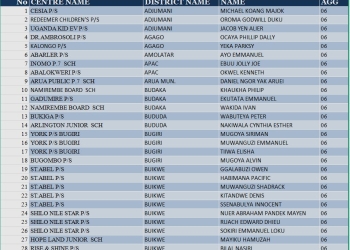A new report indicates high prevalence of child labor in the coffee supply chain in the Bugisu sub region with about 48 percent of children found working the coffee supply chain.

The report follows a study conducted by the Makerere University based AfriChild Centre with Primary data collection taking place in 771 households from four districts including Mbale, Kapchorwa, Sironko, and Bududa between July and August last year.
The study indicates that many of the children involved are boys with this challenge being more prevalent in Kapchorwa at 65% followed by Bududa at 50%
Under the law, all children are prohibited from engaging in gainful employment as this exposes them to dangers and denies them an opportunity to attend school but also to grow
Alex Arinaitwe, the Research Coordinator at Afri child , speaking at the annual child centered civil society organizations symposium held at Silver Springs hotel Bugolobi ,noted that the reason why the child labor is Eastern Uganda is because of the high poverty rate in the area. Some of the children have very old parents or care takers who can’t work any more
“Secondly is the issue of Covid19, those whom were sent back home as a result of school closure ended up being employed and when schools opened again , they never went back.”
He also added that some employers prefer child labor however much its unlawful because its cheaper compared to other forms of labor available in the country.
Key findings
The overall prevalence of child labour in the coffee supply chain (CSC) was 48 percent: 51 per cent among boys and 42 percent among girls. Child labour in the CSC is more prevalent in Kapchorwa (65%) and Bududa (50%) than in Sironko (35%) and Mbale (30%). Most of the children (61%) working in the coffee supply chain did so on the instruction of one or both parents.
Four in 10 children (43%) aged 5-17 were engaged in hazardous work, including the use of sharp tools, working long hours, exposure to agro-chemicals and carrying heavy loads. For example, 13 per cent of children (aged 5-17 years) in coffee production, reported working more than the allowable number of hours for their age group.
Children take on a variety of tasks including picking and sorting berries,pruning trees, weeding, fertilizing, and transporting beans and other supplies.
Almost all child labour in the CSC happens close to production, either on or near the small family-run farms. The nature (activities) and extent (i.e., regularity of participation) vary depending on the stage in the supply chain and season.
Boys more than girls participated in more physically demanding activities such as sraying, pruning, carrying and loading.
38 per cent reported being punished when they make mistakes or fail to fulfil the required tasks. The type of punishment, among those reporting punishment, ranged from being shouted at (68%) or insulted (34%) to Physical assault (47%).
54 per cent reported suffering/experiencing at least one work-related injury or illness over the last 12 months.
Children engaged in hazardous work are more vulnerable to injuries compared to other working children who are not exposed to hazardous work: they were 36 times more likely to get injured than those not exposed to any hazard.
Among children Hazzard reported work-related injuries, 38 percent stopped working temporarily and 1 per cent stopped completely. 16 per cent temporarily stopped going to school.
Long hours of work, lack of protective Gear, and lack of training in the handling of tools were all reported to increase the risk of injuries.
Only 25 per cent of children in hazardous child labour reported using any personal protective equipment (PPE). The most widely used PPE were Gloves (91%) followed by safety boots (4%) and face masks (3%).

















